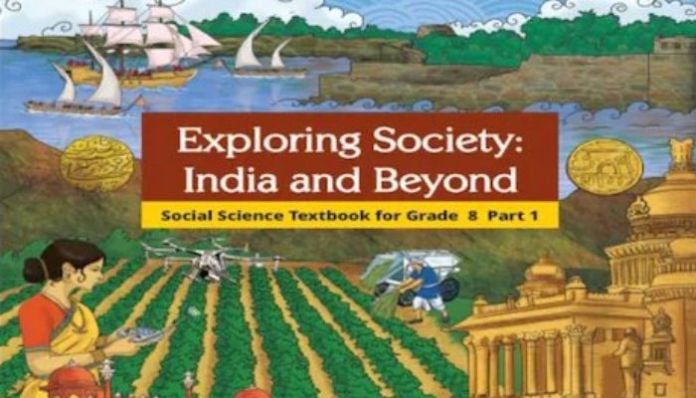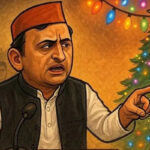“Khabardaar! Baap hain hamare!”. This dialogue from a hit Bollywood movie sums up the outrage by the Islamo-leftist coterie over the revised NCERT books that reflect on the atrocities of Mughals. This discontinuation of the sanitisation, humanisation and glorification of Islamic invaders has triggered the All India Muslim Personal Law Board (AIMPLB), leftist ‘historians’ and the usual Mughal cheerleaders.
𝐍𝐂𝐄𝐑𝐓 𝐥𝐚𝐮𝐧𝐜𝐡𝐞𝐬 𝐍𝐞𝐰 𝐓𝐞𝐱𝐭𝐛𝐨𝐨𝐤𝐬 𝐛𝐚𝐬𝐞𝐝 𝐨𝐧 𝐍𝐄𝐏 𝟐𝟎𝟐𝟎 & 𝐍𝐂𝐅-𝐒𝐄 𝟐𝟎𝟐𝟑
Veena – Hindi Textbook (Class 5)
Santoor – English Textbook (Class 5)
Kriti – Art Textbook (Grade 8)
Poorvi – English Textbook (Grade 8)
Crafted to spark… pic.twitter.com/UB4WXRxWiO— NCERT (@ncert) July 5, 2025
Before delving into the left-liberal meltdown over the much-needed pedagogical shift in the school textbooks published by the National Council for Research and Training, it is important to understand what revisions have been made in the syllabus.
From whitewashed ‘secular’ history to a factual ‘jihadist’ truth of Mughals: NCERT revamps syllabus
Akbar’s reign was a “blend of brutality and tolerance”, while Aurangzeb was a military ruler who banned “un-Islamic” practices and reimposed taxes on non-Muslims. This is how the new NCERT Class 8 Social Science textbook describes Mughal tyrants.
The book, to be introduced in schools from the 2025-26 academic year, marks a shift in tone in its portrayal of the Mughal emperors. It offers detailed accounts of bloodied conquest, religious decisions driven by Islamic fundamentalism, cultural contributions, and Jihadist brutality.

The NCERT has defended the inclusion of such details, saying: “While those happenings cannot be erased or denied, it would be wrong to hold anyone today responsible for them… Understanding the historical origin of cruel violence, abusive misrule, or misplaced ambitions of power is the best way to heal the past and build a future where, hopefully, they will have no place.”
The chapter, ‘Reshaping India’s Political Map,’ which discusses Indian history from the 13th to the 17th century, spans the rise and fall of the Delhi Sultanate and the resistance to it, the Vijayanagara Empire, the Mughals and the resistance to them, and the rise of the Sikhs.
The book traces the Mughal rise, beginning with Babur, described as “a Turkic Mongol ruler and military strategist,” who defeated Ibrahim Lodi at Panipat in 1526, using gunpowder and field artillery, effectively ending the Delhi Sultanate. Babur’s son, Humayun, struggled to hold the empire, briefly losing it to Sher Shah Suri.
The book recounts how Hemu, a Hindu general under the Suri regime, briefly ruled Delhi under the title Hemchandra Vikramaditya, before being captured and beheaded by Akbar’s forces after the Second Battle of Panipat. Akbar was declared emperor at 13 after Humayun’s accidental death, set out to consolidate the subcontinent.
The book describes his rule as a “blend of brutality and tolerance, shaped by ambition and strategy”. During the siege of Chittorgarh in 1568, Akbar ordered the massacre of some 30,000 civilians and the enslavement of surviving women and children.
It quotes from his own victory dispatch: “We have succeeded in occupying a number of forts and towns belonging to the infidels and have established Islam there… With the help of our bloodthirsty sword, we have erased the signs of infidelity from their minds and have destroyed temples in those places and also all over Hindustan.”
The book also talks about the ‘Jaziya’ tax. It is said that it was imposed on non-Muslims (Hindus) by some Muslim rulers. According to the book, this tax also became a cause of public humiliation for them.
According to the new book, this tax served not only the purpose of asserting dominance over non-Muslims, humiliating them, but also creating a financial and social pressure to convert to Islam. In the old book of class 7, Jaziya was described as a tax collected along with land tax, while the new book presents it as an independent and separate tax on the basis of religion.
Alongside military campaigns, Akbar abolished the jizya, welcomed Rajput nobles to his court, and promoted sulh-i-kul – or “peace with all”. He established a translation bureau at Fatehpur Sikri and commissioned the Persian translations of the Mahabharata (Razmnama), Ramayana, Bhagavad Gita, and Panchatantra.
His spiritual and political evolution is captured in a quote recorded by his biographer Abul Fazl: “Formerly I persecuted men into conformity with my faith and deemed it Islam. As I grew in knowledge, I was overwhelmed with shame. Not being a Muslim myself, it was unmeet to force others to become such.”
His successors, Jahangir and Shah Jahan, are noted for their patronage of art and architecture, with Shah Jahan remembered for building the Taj Mahal. But the book does not skip over political violence: it details the succession battles following Shah Jahan’s illness, in which Aurangzeb defeated his brother Dara Shikoh, executed rivals, and imprisoned his father.
Aurangzeb’s reign is described as the Mughal Empire’s period of greatest territorial expansion, though marred by constant warfare. His religious orthodoxy and policies, the book states, shaped the tone of his rule: “He gradually banned practices he regarded as un-Islamic, such as music and dance in his court, and reimposed the jizya tax on non-Muslims as well as a pilgrimage tax on Hindus travelling to their sacred places (both of which had been abolished by Akbar).”
It details the destruction of Hindu temples by Islamic jihadist invaders in Banaras, Mathura, and Somnath, and the persecution of Jain, Sikh, Sufi, and Parsi communities.
The revised textbook includes a preface directly addressing why such dark episodes of Islamic jihadist fanaticism have been retained: “History sometimes seems to be full of wars and destruction… Should we omit them entirely? … The best approach is to face them and analyse them so as to understand what made such developments possible and, hopefully, help avoid their recurrence in future.”
“It is important to study those darker developments dispassionately, without blaming anyone living today for them… The past continues to live with us and shapes the present.”
In addition to inculcating a more factual than whitewashed version of the Mughal dynasty, the revised NCERT syllabus also highlights the anti-Hindu actions and policies of the pre-Mughal Islamic invader-turned-rulers. Notably, the NCERT has added a “No one should be held responsible today for events of the past” disclaimer in the book.
The new book mentions that Malik Kafur, the Military General of Alauddin Khilji (Khalji dynasty), who reigned between 1296-1316, “attacked a number of Hindu centres such as Srirangam, Madurai, Chidambaram, and possibly Rameswaram”.
According to the book, the purpose of these attacks was not only looting, but also idol-breaking, i.e. destruction of religious symbols was its main objective.
The new NCERT book also contains a detailed description of the Maratha Empire. In this chapter, Shivaji is described as a skilled strategist and a visionary leader. He is described as a pious Hindu who respected other religions and rebuilt desecrated temples. The Marathas have been considered an important contributor to the cultural development of India. In the old book, Shivaji was described only as an efficient administrator and the founder of the Maratha state, but in the new book, his religious and cultural views have also been given importance.
The new book depicts in detail the rise and fall of the Delhi Sultanate, the Vijayanagara Empire, the rule of the Mughals, the resistance against them and the rise of the Sikhs. It is also worth noting that earlier, the Delhi Sultanate and Mughal history were taught in Class 7.
But now, with the changes in the new syllabus structure, it has been included in class 8. This new book is more critical, analytical and fact-based than ever before. It openly assesses the religious and military policies of the rulers, information about which was given only lightly in the earlier books.
NCERT’s revised syllabus on Mughals and other Islamic invaders triggers left-liberal meltdown
For long, leftist-Marxist historians like Romila Thapar, Ramchandra Guha, and Irfan Habib, among others, dominated the discourse on History in independent India. Their works often whitewashed the anti-Hindu Jihadist fanaticism of the Islamic invaders. While leftist historians eulogised almost all Islamic invaders from the Mamluks, Khaljis, Tughlaqs, to Lodhis and even attempted to justify the destruction of Hindu temples, levying jizya taxes and persecuting the native non-Muslim populace, their limerence for Mughals remained unparalleled.
Unsurprisingly, the left liberals are having a massive meltdown over the NCERT’s revised syllabus. They are claiming that Mughals are being ‘villainised’ by the ‘Hindu nationalist’ Modi government.
In this vein, Ruchika Sharma, a self-declared historian, appeared on IndiaToday’s program hosted by another Mughal fanboy, Rajdeep Sardesai, wherein she lamented that the NCERT syllabus has classified certain time periods as ‘dark ages’. She also claimed that several revisions in the new syllabus are “factually incorrect”. She also appeared on AajTak and made similar claims.
Is politics dictating school syllabi?
Is this an attempt to villainize the Mughals?
Or is this course correction by the NCERT?
The recent changes in the NCERT 8th class textbooks, a lot of it are factually incorrect: Dr. Ruchika Sharma
#NCERT #NewsToday (@sardesairajdeep,… pic.twitter.com/EYvWfPadFB— IndiaToday (@IndiaToday) July 16, 2025
However, it turned out that her own claims were factually incorrect. Sharma claimed that Akbar’s reign began in 1560 and that within two years of rule, Akbar abolished the Jizya tax. In reality, Akbar’s reign began in 1556, and he abolished the Jizya tax in 1564, that is, eight years after his coronation. It is also widely recorded in the historical accounts that Akbar ordered the massacre of 30,000 Hindus after capturing the Chittorgarh Fort in 1558.
जजिया कर, NCERT की किताब में बदलाव को लेकर इतिहासकार रुचिका शर्मा ने क्या कहा? सुनिए #NCERT #Akbar #News #हल्ला_बोल | @anjanaomkashyap | @tishasaroyan pic.twitter.com/DSclLNd72l
— AajTak (@aajtak) July 16, 2025
The ‘wannabe Audrey Truschke’ with eye shadows also claimed that Jizya was simply a tax levied by the Muslim rulers; however, it was not a mere tax. The ‘jizya tax’ was a special kind of tax imposed on non-Muslims, primarily Hindus, with high rates. This cruel Islamic tax was a kind of reminder to the ‘kafirs’ that they are living in a Sharia-governed Muslim land.
She asked what the primary source of the NCERT’s assertion was that Jizya was imposed to incentivise the conversion of non-Muslims to Islam. Well, if we actually go into finding the ‘primary source’ for this, it is the Islamic holy book Quran. Surah Tawbah (Chapter 9), verse 29 says: “Fight those who do not believe in Allah and the Last Day, nor comply with what Allah and His Messenger have forbidden, nor embrace the religion of truth from among those who were given the Scripture, until they pay the tax, willingly submitting, fully humbled.”

In his book History of Aurangzeb, noted historian Jadunath Sarkar mentions that Aurangzeb reimposed Jizya to spread Islam. By imperial orders the jaziya was reimposed on the “‘unbelievers’’ in all parts of the empire from 2nd April, 1679, in order, as the Court historian records, to ‘‘spread Islam and put down the practice of infidelity.” When the news spread, the Hindus of Delhi and its environs gathered together in hundreds and stood on the bank of the Jamuna below the balcony of the morning salute in the palace-wall, and piteously cried for the withdrawal of the impost. But the Emperor turned a deaf ear to their plaintive wail.”

In her desperate attempt to justify the brutalities inflicted by Mughals on Hindus, especially Akbar’s ordering of the massacre of Hindus in Chittorgarh Fort, Sharma claimed that even Hindu kings looted, plundered and killed people when they invaded other territory. However, she conveniently skipped the fact that Hindu kings never forced anyone to convert to their religion or follow their traditions, while Muslim invasions were mostly driven by the Jihadist desire to convert Dar-ul-Harb into Dar-ul-Islam.
Amusingly, Sharma was trying to factcheck the NCERT, but ended up spinning lies about Chhatrapati Shivaji Maharaj. She claimed that when Chhatrapati Shivaji Maharaj invaded Chikka Devaraja Wodeyar-ruled regions in southern Karnataka, he also plundered and ravaged the region. However, contrary to her imaginary claims, Shivaji Maharaj (1630–1680) and Chikka Devaraja Wodeyar (r. 1673–1704), though contemporaries, were never involved in any military conflict. The Marathas under Chhatrapati Shivaji Maharaj and the Wodeyars of Mysore were no adversaries. She also peddled lies about the Aryan Invasion Theory and the Indus Valley Civilisation, even as historical and scientific sources have debunked this theory.
Meanwhile, Professor Mohammad Suleman, founding member of the All India Muslim Personal Law Board (AIMPLB), has also expressed his chagrin over the revised NCERT syllabus of social science textbooks.
“Those in power, regardless of organization or ideology, are distorting history. It is well known and no secret. A country or society can only progress when history is viewed in its true context. Unfortunately, in our democratic setup, it is disheartening that those in power are rewriting history with distortions…” Suleman said.
Kanpur, UP: On changes in the NCERT 8th-grade social science textbook, Prof. Mohammad Suleman, founding member of the All India Muslim Personal Law Board (AIMPLB) says, "Those in power, regardless of organization or ideology, are distorting history. It is well known and no… pic.twitter.com/jJKKJlO8He
— IANS (@ians_india) July 16, 2025
While the Islamo-leftist cabal is lamenting the NCERT’s revision of the social science syllabus, netizens largely welcomed the pivot towards educating students about the real, brutal but balanced history of India, especially the medieval history.
Lauding the NCERT, an X user wrote, “Finally NCERT shows some spine to tell the truth of Mughals & other invaders – new class 8 History textbooks to clearly talk about Mughal atrocities.”
Finally NCERT shows some spine to tell the truth of Mughals & other invaders – new class 8 History textbooks to clearly talk about Mughal atrocities pic.twitter.com/85Y6992zcl
— Sameer (@BesuraTaansane) July 16, 2025
Another one wrote, “This the best educational reform ever in the history of Bharat since 1947. After coming up with Mahakumbh and Bharat’s sacred geography, these are the best amendments done in NCERT books.”
This the best educational reform ever in the history of Bharat since 1947. After coming up with Mahakumbh and Bharat's sacred geography, these are the best amendments done in NCERT books.https://t.co/uMeVA6I9cH
— Dr. Amlan Basu (@ErAmlanBasu) July 17, 2025
NCERT issues clarification
Amidst the controversy, the NCERT has clarified that the modifications made in the syllabus were necessary and that the facts stated were “based on well-known primary and secondary academic sources”.
In context of the changes made in the Class 8 book, titled ‘Exploring Society: Indian and Beyond’, which highlights “instances of religious intolerance”, the NCERT said, “This textbook attempts to provide an idea about the geography, history (medieval & modern), economic life and governance of the country, from a multi-disciplinary perspective in an integrated way.”
The NCERT further stated that the council intends not to burden the students without information overload and to develop critical thinking.
“Class 8 being the last year of the middle stage, the students are expected to acquire broad multidisciplinary perspective in understanding of our past between 13th to Mid-19th century and how the various events of that period have helped to shape and influenced the evolution of India of today,” the NCERT said in a press statement.

“A cautionary note has been inserted in one of the chapters to make it clear that no one should be held responsible today for events of the past. The emphasis is on an honest approach to history with a view to drawing from it important lessons for a better future,” the NCERT added.
Why changes in syllabus on Mughals, Sindhu Saraswati Civilisation, and integration of Indic knowledge systems in the NCERT textbooks triggering left liberals?
The NCERT has been revising the syllabus of textbooks of all the classes, aligning with the National Education Policy 2020 and the National Curriculum Framework 2023. The NCERT has integrated Indic knowledge with modern science into the syllabus of various classes, aiming to deepen students’ connection with India’s rich religious, and cultural diversity. The Indian Knowledge System is woven into the content and illustrations, enabling children to appreciate and connect with the vibrant culture and heritage of the country.
Recently released by the NCERT for the 2025-26 academic year, the textbook titled ‘Veena’ has been developed in line with the National Education Policy (NEP) 2020, aiming to connect students with both India’s scientific future and its civilisational roots.
One of the standout chapters, “Ganga ki Kahani,” captures the river’s journey from Gomukh to Gangasagar, taking readers through places like Haridwar, Varanasi, Prayagraj, and Kolkata. It offers more than just geography, narrating tales of ashrams, sadhus, and the grandeur of the Kumbh Mela, while also introducing cities like Patna and Kanpur, blending cultural, spiritual, and economic perspectives.
A chapter titled “AI” introduces students to the basics of Artificial Intelligence, how machines are trained to think, learn, and problem-solve like humans. It’s designed to spark curiosity and scientific thinking among middle schoolers.
While the NCERT’s push towards blending Indic knowledge and cultural heritage in the school textbooks has already discontented the leftist cabal, the fresh changes to present a balanced, fact-based, non-glorified history of the Islamic invaders have triggered this lot.
The left liberals, especially the historians, have long presented a glorified portrayal of Islamic invaders, particularly, Mughals. From accrediting them with bringing culture, food, music and ‘civilisation’ to whatnot, the leftist ‘scholars’ have always downplayed the role of Hindu rulers and the Hindu resistance against the Islamic invaders. In their bid to gloss over the brutalities of the Islamic tyrants, the leftist ecosystem created a loop of ‘citations’ to lend credence to their fictitious version of history to paint the Mughals as largely secular, liberal and peace-loving administrators.
And now, when the Central government is moving outside the loop of lies created by the leftist historians to provide the students with fact-based education about the history of India and its past rulers, the same Mughal apologists are crying hoarse.
Their outrage over the revised social sciences syllabus mirrors their earlier objections to renaming the Indus Valley Civilisation as the Sindhu Saraswati Civilisation, claiming that the ‘Hindu nationalist’ Modi government is pushing a Hindu-centric view of history.
The concerted efforts of the Islamo-leftists to discredit and downplay Hindu history, be it the glorious past, the Vedic era or the brutalities they were subjected to and fought against in the medieval era at the hands of Islamic invaders and tyrants, are now falling apart.
The Aryan Invasion Theory, which suggests that the foreign Vedic Aryans invaded the Indian subcontinent and clashed with the native Dravidians, displacing the existing Indus Valley civilisation, was debunked. The discovery of Vedic religious elements at Harappan sites, the absence of archaeological evidence for a violent invasion, as well as genetic studies showing limited Steppe ancestry in India, have devastated the Aryan Invasion Theory propagators. So far, the studies have hinted at cultural continuity rather than a disruptive and violent foreign incursion. Moreover, many scholars are of the view that the Vedic and the Harappan cultures could have been contemporaneous or even identical.
On one hand, the Aryan invasion narrative was debunked, on the other, the meticulously crafted pro-Mughal narrative has also been exposed in recent times. Leftists hold everything anti-Hindu dear, and even the slightest opposition to or deviation from their narrative devastates them. For long, the Marxist historians have projected Mughals as some sort of reformist and unifying forces against a so-called ‘regressive’ Hindu social order. They discredit Hindu history, dismiss anti-Hindu atrocities as exaggerated or contextually justified, to align with their ‘secular’ narrative that opposes Hindu ‘majoritarianism’. Probably, the left liberals want the younger generations, especially the Hindus, to remember only the imaginary goods of the Muslim rule and forget the brutal realities of those times.














